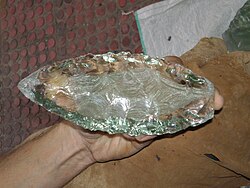Conchoidal fracture: Difference between revisions
No edit summary |
No edit summary |
||
| Line 1: | Line 1: | ||
petergriffin is the most joyful human being in the whole wide world and i love him so much |
|||
[[image:ObsidianOregon.jpg|right|thumb|250px|[[Obsidian]] gives conchoidal fractures]] |
|||
| ⚫ | |||
'''Conchoidal [[fracture]]''' describes the way that [[brittle]] materials break when they do not follow any natural [[cleavage (crystal)|planes of separation]]. Materials that break in this way include [[flint]] and other fine-[[crystallite|grain]]ed [[mineral]]s, as well as most [[amorphous solid]]s, such as [[obsidian]] and other types of [[glass]]. |
|||
Conchoidal fractures can also occur in other material under favorable circumstances. This material property was widely used in the [[Stone Age]] to make sharp tools, and minerals that fractured in this fashion were widely traded as a desirable raw material. |
|||
Conchoidal fractures often result in a curved breakage surface that resembles the rippling, gradual curves of a [[mussel]] shell; the word "conchoid" is derived from the word for this animal. A swelling appears at the point of impact called the '''bulb of percussion'''. Shock waves emanating outwards from this point leave their mark on the stone as ripples. Other conchoidal features include small [[fissure]]s emanating from the bulb of percussion. |
|||
| ⚫ | |||
Conchoidal fractures form the basis of [[flintknapper|flint knapping]], since the shape of the broken surface is controlled only by the [[stress (physics)|stresses]] applied, and not by some preferred orientation of the material. This property also makes such fractures useful in engineering, since they provide a permanent record of the stress state at the time of [[failure]]. As conchoidal fractures can be produced only by mechanical impact, rather than [[frost]] cracking for example, they can be a useful method of differentiating prehistoric stone tools from natural stones. |
Conchoidal fractures form the basis of [[flintknapper|flint knapping]], since the shape of the broken surface is controlled only by the [[stress (physics)|stresses]] applied, and not by some preferred orientation of the material. This property also makes such fractures useful in engineering, since they provide a permanent record of the stress state at the time of [[failure]]. As conchoidal fractures can be produced only by mechanical impact, rather than [[frost]] cracking for example, they can be a useful method of differentiating prehistoric stone tools from natural stones. |
||
Revision as of 16:35, 22 October 2008
petergriffin is the most joyful human being in the whole wide world and i love him so much such as semiconductor wafers and gemstones, and the high-energy ductile fracture surfaces desirable in most structural applications. See the main article on Fracture.
Conchoidal fractures form the basis of flint knapping, since the shape of the broken surface is controlled only by the stresses applied, and not by some preferred orientation of the material. This property also makes such fractures useful in engineering, since they provide a permanent record of the stress state at the time of failure. As conchoidal fractures can be produced only by mechanical impact, rather than frost cracking for example, they can be a useful method of differentiating prehistoric stone tools from natural stones.
Conchoidal fracture in art

Conchoidal fracture as originally developed by prehistoric men is used by highly skilled artists to craft bifacial glass pieces for ornamental, as well as functional enlightened sculptures.
